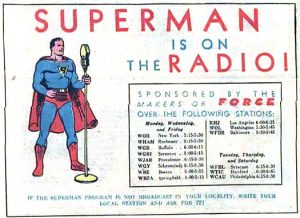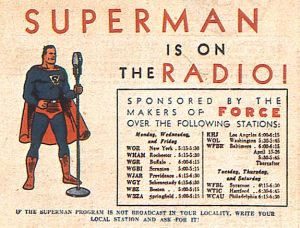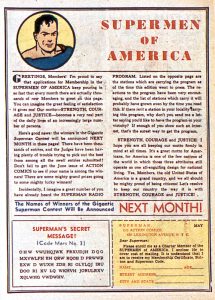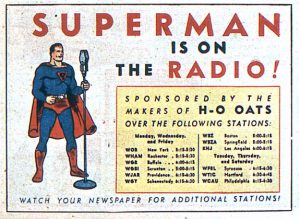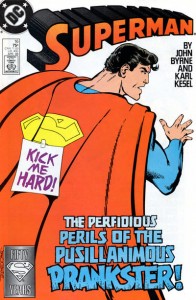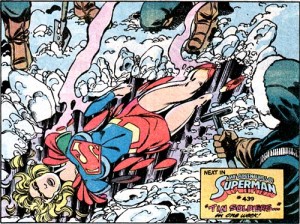As part of Super-Hearing, I want to trace how the Superman radio show was promoted in comic books. This ad from ACTION COMICS #26 is identical to the one from ACTION COMICS #25 and SUPERMAN #5, save for removal of the date material. The ads might be stagnant now, but the market is about to boom!
Posts Tagged ‘Action Comics’
As part of Super-Hearing, I want to trace how the Superman radio show was promoted in comic books. This ad from ACTION COMICS #25 picks up largely from the one in ACTION COMICS #24, but adds listings for stations in Washington and Baltimore airing the show.
Also of note is a change in sponsor from H-O Oats to Force, a toasted wheat flakes cereal produced by the same company. Force would be the most prominent sponsor of the show during its syndicated run.
As part of Super-Hearing, I want to trace how the Superman radio show was promoted in comic books. Less than a month and a half after it debuted, the serial got its first mention in the medium that launched the character on the popular Superman of America page in ACTION COMICS #24. The text, written as though penned by Superman himself, encourages readers to not just listen to the show, but to encourage their local stations to air the program if they aren’t already.
It also refers to a list of stations currently airing the show in various markets across the United States. This list was included in a half-page ad on following page of the comic. Similar ads were run in Superman-related comics for the next couple years, so we’ll be able to somewhat chart the growth of the show through these ads.
H-O Oats, manufactured by Hecker’s Oat Cereal, was an early sponsor for the show in many markets, particularly on the East Coast of the U.S. The ad also makes it clear the transcribed show aired on different days in different markets. Airdates used for Super-Hearing are based on those researched by Michael J. Hayde for his book, “Flights of Fantasy.”
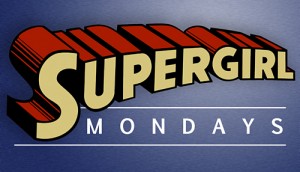 As Supergirl takes flight in her newest incarnation in the form of her first live-action television show, I thought it would be interesting to take a look back at an era for the character that is not only one of the most divisive, but also likely will be, in time, one of the most historically ignored: the post-Crisis Supergirl.
As Supergirl takes flight in her newest incarnation in the form of her first live-action television show, I thought it would be interesting to take a look back at an era for the character that is not only one of the most divisive, but also likely will be, in time, one of the most historically ignored: the post-Crisis Supergirl.
Coming into comics with the death of Superman, “Funeral For a Friend” and “Reign of the Supermen,” the post-Crisis incarnation of Supergirl also is one that cemented a love of the character that, for me, is nearly as strong as my love for Superman. And while there are podcasts, blogs and Tumblrs, centered on this era of Superman comics, none have done so with a specific focus on Supergirl’s story.
So to that end, we begin Supergirl Mondays, a weekly issue-by-issue retrospective of the Maid of Might’s story in the post-Crisis universe. Each Monday, before the airing of “Supergirl” on CBS, take a look back at the the earliest days of the incredible, winding and, yes, at times, somewhat confusing journey of the all-new, all-different Supergirl.
While DC Comics’ copyrighting of the Supergirl name goes back to 1944, and a few of female characters calling themselves Supergirl (or even Superwoman) appeared throughout the next 15 years, the most well-known version of the character, Kara Zor-El, Superman’s Kryptonian cousin, debuted in ACTION COMICS #252 (cover date May 1959) in “The Supergirl From Krypton,” which was written by Otto Binder and illustrated by Al Plastino.
The character was an immediate success and went on to fill the back-up slot in that book for more than a decade. She then moved over to headline DC’s long-running ADVENTURE COMICS in 1969, where she stayed until getting her own self-titled, although short-lived, book in 1972. As comics moved into the Bronze Age, Supergirl shifted into a recurring spot in the then-new SUPERMAN FAMILY, her guest appearances in Superman-related stories increased exponentially, and she was given her own self-titled book in 1982.
Unfortunately, despite also starring in her own big-screen movie in 1984 (a move spurred on by the success of the Christopher Reeve series of Superman films), the character’s fate was sealed with DC’s landmark CRISIS ON INFINITE EARTHS in 1985 when DC editorial chose to kill the character in an iconic moment for the series and DC history. In the wake of that series, Superman’s history was rewritten, and Kara Zor-El no longer existed as DC sought to return Superman to being the sole survivor of Krypton.
But, despite the new editorial direction, the disappearance of Kara Zor-El didn’t mean Supergirl was gone forever.
Issue: SUPERMAN (Vol. 2) #16
Cover date: April 1988
Cover price: 75 cents ($1 Can./40p U.K.)
Cover by John Byrne
Story: “He Only Laughs When I Hurt!”
Story and pencils by John Byrne
Inking by Karl Kesel
Coloring by Tom Ziuko
Lettering by John Costanza
Editing by Michael Carlin
Superman created by Jerry Siegel and Joe Shuster
After the main story details Superman’s inaugural run-in with Oswald Loomis, a.k.a. the Prankster, an epilogue takes us to later that night in Antarctica where heat sensors alert a group of U.S. Navy scientists of something buried within the ice. Investigating further, the men are stunned by what they find.
I can only imagine what readers of the time — especially those who had been reading the books since before the reboot and, perhaps, still were mourning the loss of a much-beloved character — thought of this shocking end.
Is this Kara Zor-El returned somehow? A new character? A hoax? A dream? An imaginary story?
Adding to the mystery is Byrne’s redesign of the costume, which with exceptions of the lack of a headband and touch of red on her shoulders — and the hardly noticeable red piping on the top of her boots rather than yellow, is essentially the same as the final costume worn by Kara.
It’s an interesting way to begin the story of a new Supergirl, that much is sure.
Next time on Supergirl Monday: The mystery deepens.
A comment on a recent episode of Wahoo! A Sgt. Fury and His Howling Commandos Podcast got me thinking about Nazis.
On Wahoo!, hosts Brian and Dion discuss Sgt. Fury stories taking place during World War II, but published in the 1960s, long after the end of the war. But comics had been popular for decades before then, with Superman’s debut, generally considered the beginning of the comics industry as we know it today, coming in 1938.
So as the war in Europe began heating up, what was comic books’ response? Judging by the covers, DC Comics and Marvel Comics took very different approaches to the war.
Marvel came out swinging as early as MARVEL MYSTERY COMICS #4 (cover date February 1940), which featured one of their top heroes at the time, the Sub-Mariner, plowing through a trio of Nazi seamen.
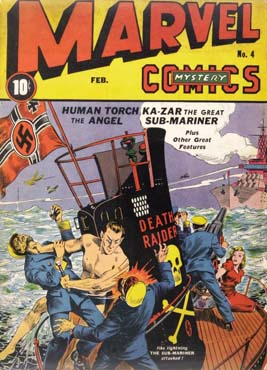
The Submariner and Marvel’s other headlining hero, the Human Torch, continued to occasionally chop down Nazi forces on covers every few months for the next year. Then in 1941, Marvel debuted their big gun as Captain America hit the scene like a sock to Hitler’s jaw — literally (or at least visually!) on the cover to CAPTAIN AMERICA COMICS #1 (cover date March 1941).
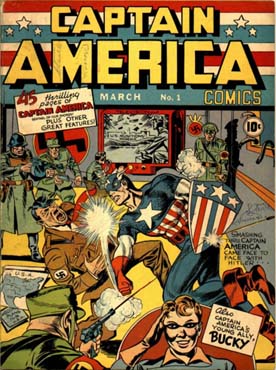
And with the Star-Spangled Avenger leading the way, the proverbial floodgates were opened. Until the end of the war, to not see one of Marvel’s super-heroes taking on Nazi, SS or Axis troops on a cover seems to be the rarity.
But over at DC Comics, it was a very different story.
There certainly was no shortage of pro-America covers and those promoting the purchase of war bonds and stamps. A smattering of books even featured Superman or other heroes fighting back generic and non-descript armies. But it wasn’t until more than a year after the bombing of Pearl Harbor that the specific enemy in that war was shown with ACTION COMICS #58 (cover date March 1943) and the infamous and unfortunate “slap a Jap” cover.
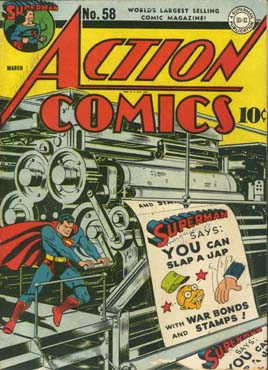
The next month, things spread a bit farther across the line with four covers (WORLD’S FINEST COMICS #9, STAR SPANGLED COMICS #19, BOY COMMANDOS #2 AND ACTION COMICS #59) directly addressing the Axis threat.
But afterward, things again quieted down. Through Japan’s formal surrender in the fall of 1945, covers occasionally addressed the war effort, encouraged purchasing war bonds and even featured heroes taking on Axis forces. But, such covers were mainly found on issues of titles featuring Superman (SUPERMAN and ACTION COMICS) or Jack Kirby and Joe Simon’s Commandos (STAR SPANGLED COMICS and their own self-titled book).
And such covers never came with the frequency or gusto of Marvel. The majority of DC’s war-themed covered focused on supporting the troops and being pro-America, rather than taking down the Nazis and other Axis members.
And that’s not to say there’s anything wrong with either approach, and an in-depth look at the insides of books from both companies might tell yet two more stories. But I find the difference on their covers, at the very least, interesting. And I’m curious why such a difference exists, though we will likely never know.
But if you were a member of the Axis, would you want this coming at you?
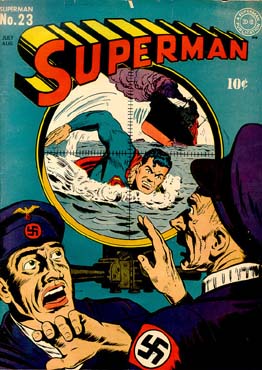
Me, neither.
(Special thanks to Mike’s Amazing World for help with this post.)
